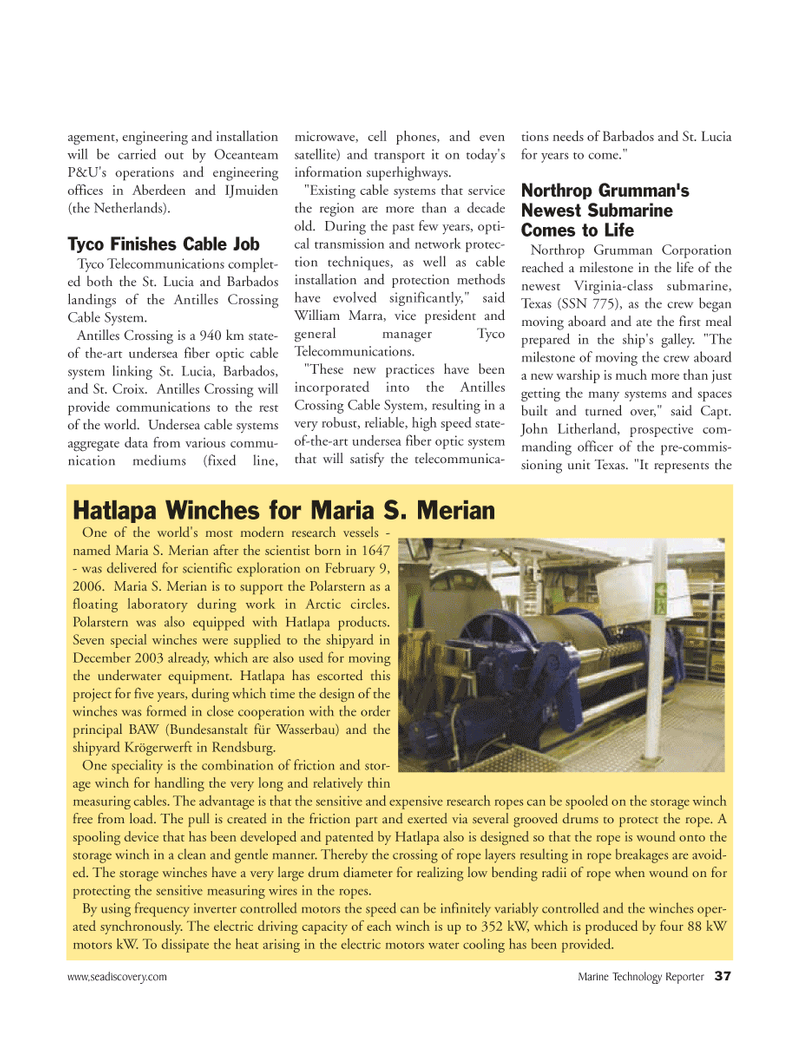
Page 37: of Marine Technology Magazine (May 2006)
The Communications Edition
Read this page in Pdf, Flash or Html5 edition of May 2006 Marine Technology Magazine
www,seadiscovery.com Marine Technology Reporter 37 agement, engineering and installation will be carried out by Oceanteam
P&U's operations and engineering offices in Aberdeen and IJmuiden (the Netherlands).
Tyco Finishes Cable Job
Tyco Telecommunications complet- ed both the St. Lucia and Barbados landings of the Antilles Crossing
Cable System.
Antilles Crossing is a 940 km state- of the-art undersea fiber optic cable system linking St. Lucia, Barbados, and St. Croix. Antilles Crossing will provide communications to the rest of the world. Undersea cable systems aggregate data from various commu- nication mediums (fixed line, microwave, cell phones, and even satellite) and transport it on today's information superhighways. "Existing cable systems that service the region are more than a decade old. During the past few years, opti- cal transmission and network protec- tion techniques, as well as cable installation and protection methods have evolved significantly," said
William Marra, vice president and general manager Tyco
Telecommunications. "These new practices have been incorporated into the Antilles
Crossing Cable System, resulting in a very robust, reliable, high speed state- of-the-art undersea fiber optic system that will satisfy the telecommunica- tions needs of Barbados and St. Lucia for years to come."
Northrop Grumman's
Newest Submarine
Comes to Life
Northrop Grumman Corporation reached a milestone in the life of the newest Virginia-class submarine,
Texas (SSN 775), as the crew began moving aboard and ate the first meal prepared in the ship's galley. "The milestone of moving the crew aboard a new warship is much more than just getting the many systems and spaces built and turned over," said Capt.
John Litherland, prospective com- manding officer of the pre-commis- sioning unit Texas. "It represents the
Hatlapa Winches for Maria S. Merian
One of the world's most modern research vessels - named Maria S. Merian after the scientist born in 1647 - was delivered for scientific exploration on February 9, 2006. Maria S. Merian is to support the Polarstern as a floating laboratory during work in Arctic circles.
Polarstern was also equipped with Hatlapa products.
Seven special winches were supplied to the shipyard in
December 2003 already, which are also used for moving the underwater equipment. Hatlapa has escorted this project for five years, during which time the design of the winches was formed in close cooperation with the order principal BAW (Bundesanstalt für Wasserbau) and the shipyard Krögerwerft in Rendsburg.
One speciality is the combination of friction and stor- age winch for handling the very long and relatively thin measuring cables. The advantage is that the sensitive and expensive research ropes can be spooled on the storage winch free from load. The pull is created in the friction part and exerted via several grooved drums to protect the rope. A spooling device that has been developed and patented by Hatlapa also is designed so that the rope is wound onto the storage winch in a clean and gentle manner. Thereby the crossing of rope layers resulting in rope breakages are avoid- ed. The storage winches have a very large drum diameter for realizing low bending radii of rope when wound on for protecting the sensitive measuring wires in the ropes.
By using frequency inverter controlled motors the speed can be infinitely variably controlled and the winches oper- ated synchronously. The electric driving capacity of each winch is up to 352 kW, which is produced by four 88 kW motors kW. To dissipate the heat arising in the electric motors water cooling has been provided.
MTR#4 (33-48).qxd 5/8/2006 10:09 AM Page 37

 36
36

 38
38
